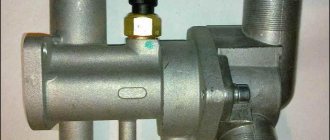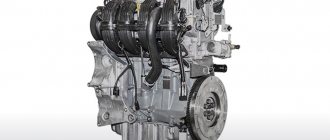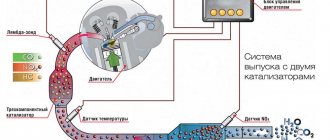All cars whose engines are cooled by a special liquid have at their disposal a device called a thermostat. Lada Granta is no exception.
In the Grant model, the thermostat is located between the radiator and the engine. In the article we will talk about the concept of a car thermostat, what components it consists of and how it functions, and also consider the main types of thermostat malfunctions.
The thermostat is called the antifreeze (antifreeze) temperature regulator in the engine cooling system. It increases the engine warm-up rate and maintains the required thermal state.
The key job of the thermostat is to hold back the flow of radiator fluid until the engine has warmed up. If the engine remains cold, the coolant does not pass through it to the radiator.
The thermostat opens when the engine temperature reaches 95 degrees. Thanks to its operation, the engine warms up faster. Thus, in the Lada Granta, the thermostat reduces the amount of harmful emissions and reduces engine wear to a minimum.
If desired, you can clearly see the operation of the thermostat at home. Place the thermostat in a container filled with water, then place it on the electric stove. As the moment of boiling water approaches, the thermostat valve will open approximately 2 cm. It is recommended to experiment with a new thermostat without removing yours from your own car.
Thermostat structure and operating conditions
The thermostat contains metals such as copper and brass alloy. The essence of the device's operation lies in a small cylinder turned towards the engine.
In the middle of the cylinder there is a synthetic wax ball, which at a certain temperature (82 degrees Celsius) begins to melt (the wax expands significantly under the influence of heat, changing its solid state to a liquid).
A special pin is pressed into the wax cylinder and is connected to a valve. When the wax melts, as a result of expansion, it begins to squeeze the pin out of the cylinder, while opening the valve through which coolant flows. When the engine stops and cools, the wax in the thermostat hardens and returns to its solid state.
About the nuances of installation
You may be interested in: Ford computer diagnostics: complete vehicle check
The device is mounted at the top of the engine in the area where the coolant exits into the radiator unit. It helps to quickly warm up the vehicle, holding back cooling until the engine reaches an elevated temperature. The essence of the device lies in three elements: a cylinder, a pin, and wax. A scheme of this state has been used for a long time, without undergoing any special modernization, including in new brands of cars. As a result, engine parts do not wear out prematurely, and their dynamic performance improves.
Basic thermostat malfunctions
The thermostat is a small, but no less important component of the car. A malfunctioning thermostat will most likely strand you on the side of the road. There are many reasons why a thermostat fails, but the most popular reason is corrosion.
If the thermostat is stuck and is in the completely closed position, the engine will most likely overheat, regardless of the driving mode and ambient air temperature.
If the thermostat is in the open position, but not all the way, the motor will overheat, but there is a possibility that it will not “boil”. Whether this happens or not depends on how the car is used.
If the thermostat valve is held in a completely or partially open position, it will take a very long time for the engine to warm up to the required operating temperature; in winter, the engine may not reach such a temperature.
With a working cooling system at a temperature of zero degrees, the engine warm-up time should take up to 10 minutes. In case of defective opening, the engine temperature will not rise above 70 degrees even in summer.
In both of these cases, it is necessary to replace the thermostat on the Grant or any other car. Next, let's look at how to check whether our thermostat is functioning.
About the types of thermostats
You may be interested in: How to charge a completely discharged car battery: tips and tricks for motorists
Models differ in cost and principle of operation.
Products from the German automobile industry have become very popular on the market, but they are characterized by a high price. Domestic units have adapted well to the design of modern cars of any brand, but sometimes they malfunction ahead of time. In general, since 2006, the production of thermostats in Russia has been discontinued. There are former Stato products, but today the plant has been reconstructed into Pramo. He repackages Chinese thermostats and sends them to the car market under his own brand name. Other “native” enterprises have chosen a similar operating algorithm. Those working in the Vladimir region can be considered to have increased quality control.
Drivers are more interested in universal variations. What types are available on the market?
- Single-valve version with a valve “plate” and a thermostatic element. It is considered to be in demand due to its ability to be mounted on different cars. Sometimes it is not able to satisfy all the needs of the engine, but it does an excellent job using propulsion systems from the UMP company.
- The advantage of a two-stage device is the presence of two valves. Today, manufacturers offer improved functions.
- A progressive idea of engineers, successfully implemented in life, is an electronic thermostat. Thanks to the advanced capabilities of regulating the opening and closing of the valve, the engine can operate in different modes. This leads to reduced fuel consumption, less engine wear, and facilitates easy handling in difficult road conditions. The model is suitable for foreign cars, cars of the last ten years, with a good on-board computer and with the option of thermostat control. High accuracy of operation, the possibility of manual and automatic control add advantages to the “piggy bank” of worthy development moments.
How to tell if the thermostat is working correctly
In order to find out whether the thermostat is working or not, it is necessary to warm up the engine so that the arrow indicating the temperature does not reach the red mark of the indicator quite a bit.
After that, turn off the engine, go to the hood and open it, look for the upper radiator hose. This rubber hose is usually black in color and is approximately 5cm in diameter.
There are metal clamps at its ends. The upper hose is attached to the top of the radiator. Then we look for the lower hose. It looks like the top one, only it is attached to the bottom of the radiator.
Touch the hoses carefully; they may be hot enough to burn you. If the engine temperature indicator shows that the engine is hot, but one of the hoses is cold, then most likely the thermostat valve is closed and is not allowing coolant through the radiator.
A little about operation
You may be interested in: Car body welding: types, description, technology
The make of the car dictates the type of thermostat used. They can all be configured differently. Therefore, among the characteristics, the most important thing is what thermostat opening temperature is determined by the manufacturer.
The brand of the device is indicated on its body. It can be installed not only in the motor block, but also in a specially designated place for it. The operation of the valve is based on the melting of wax placed in a cylinder-shaped hole towards the power section. Depending on the brand, the opening temperature of the thermostat valve may vary.
In the design, the temperature parameter reaches 80 degrees, the wax expands its area, squeezing out the cylinder locking pin. The result is the unlocking of the system and the action of the coolant.
Removing the thermostat Lada Granta
The thermostats of the 8-valve engines and the 16-valve Lada Granta engine are located differently, and therefore their replacement for these engines is shown separately. To remove the thermostat of the VAZ-11183, VAZ-21116 and VAZ-11186 engines, do the following: 1. Remove the plug from the expansion tank. Unscrew the drain plug at the bottom of the right radiator tank. Drain the coolant that comes out of the engine radiator into a container. Screw the drain plug back in.2. Release the clamp on the coolant temperature sensor wiring harness. 3. ...and disconnect the block from the sensor
4. Loosen the clamp securing the rear hose to the thermostat cover...
5. ...and remove the hose from the cover fitting
6. Similarly, disconnect the front hose from the thermostat housing pipe.
7. Unscrew the nut securing the ground wire to the upper stud securing the thermostat housing...
8. ...and remove the nut, washer and wire end from the stud.
9. Unscrew the two nuts securing the thermostat housing, remove the washers installed with the nuts...
10. ...and remove the thermostat housing from the studs.
Replace the thermostat housing gasket with a new one each time you disassemble the connection.
11. Remove the three bolts securing the thermostat cover and remove the cover.
12. Overcoming the force of the spring, press down the thermostat fixing plate...
13. ...then, turning it in any direction, disengage it from the grooves...
15. Remove the spring from the housing.
17. Before installing a new thermostat, check it by immersing it in water heated to a temperature of 78-80 'C. Heat the water, stirring constantly, to a temperature of (87±2) 'C.
18. At a temperature of (87±2) 'C, the thermostat rod should begin to move out of the power element. If this does not happen, replace the thermostat.19. Install the thermostat into the housing in the reverse order of removal, and the cover onto the housing.
Replace the cover seal with a new one during each disassembly and reassembly.20. Install the thermostat to the engine in the reverse order of removal.21. Fill the cooling system with liquid (see “Replacing Lada Granta coolant”). Close the expansion tank cap, start the engine, check for coolant leakage through the thermostat hose connections and warm the engine at idle to operating temperature to remove any air pockets from the system. You can see how to remove the thermostat on a 16-valve Lada Granta engine in the article “Removing the thermostat on a Lada Priora car”
Expert opinion
Drivers of VAZ horses are recommended to undergo timely diagnosis. Considering that the opening temperature of the thermostat in the VAZ-2110 is 80 0C, you can check its condition as follows.
- The launch should not be delayed: 7 minutes is the optimal time period. Next, open the hood and touch the lower pipe. When in good condition, the hoses should have the same temperature. A difference in the indicator indicates a problem. The main thing is to prevent air locks from appearing, which will result in overheating and the need for urgent replacement.
- When starting the engine, you need to touch the tube leading to the coolant. In normal condition, it is cold until the engine warms up to the desired condition.
- Complex diagnostic methods include dismantling the system and dipping it into a heated liquid. The “saucepan” method can only characterize the operating state of the thermostat, without identifying problems.
To determine the required thermostat parameters suitable for a particular “iron horse”, it is necessary to take into account the valve opening temperature. Therefore, it is better to go to a specialized auto store.
Checking the serviceability of the Lada Granta thermostat
To check the thermostat on a Lada Granta car, start the engine and touch the lower radiator hose with your hand; it should be cold. After the coolant temperature reaches 85-92 'C, the hose should begin to heat up. If this does not happen, remove the thermostat and check its functionality. To check the removed thermostat, follow the procedures in paragraphs 17-18 (see instructions above)
Parts for modifying the Lada Granta thermostat
Installation diagram
A fitting will be cut into the thermostat to supply heating to the throttle assembly
Slightly modified scheme
The next and, perhaps, the most basic modification is the installation of another thermoelement from the WAHLER 3091.92D (92C) . We begin to install the thermoelement from the WAHLER 3091.92D (92C) thermostat into the VAZ 2190 thermostat.
From this thermostat we only need the thermoelement itself and the spring. We cut the thermostat according to the diagram shown in the figure below, and remove the elements we need, then we install them into the thermostat from Granta!
The arrows indicate the places where you need to cut the thermostat.
We need a thermocouple and a spring, the body is in the trash.
Installing new elements in a VAZ 2190 thermos
Parts from WAHLER 3091.92D took their place
The next modification will be to introduce an additional fitting into the thermostat cover, which will supply OX to heat the throttle assembly. There is nothing much to talk about here, a fitting was purchased, a hole was drilled in the lid and the thread was cut. Next, install the fitting through the copper washer. Everything was thoroughly sealed with sealant.
Removing and checking the thermostat
If the thermostat is working properly, after starting a cold engine, the lower hose leading from the radiator should remain cold for some time, and then (after the coolant temperature exceeds 85 ± 2 °C) quickly heat up, which indicates the start of coolant circulation in a large circle. To dismantle the thermostat, remove the air supply hose to the throttle assembly (see “Removing the air supply hose to the throttle assembly”) and the air filter (see “Removing the air filter and air intake”). Drain the liquid from the cooling system (see “Replacing the coolant”).
Having released the clamp of the engine control system wiring harness block, disconnect the block from the coolant temperature sensor connector. Using a 13 mm wrench, unscrew the nut securing the tip of the “mass” wire to the thermostat housing...
...remove the wire end from the stud.
Using the “8” head, loosen the tightening of the clamp securing the radiator supply hose...
...and remove the hose from the thermostat housing pipe.
Similarly, disconnect the fluid supply hose to the heater radiator from the thermostat cover pipe.
Using a 13mm socket, unscrew the two nuts securing the thermostat housing and remove the housing from the cylinder head studs.
The connection between the thermostat housing and the cylinder head is sealed with a gasket.
Using a Torx T‑30 wrench, unscrew the three screws securing the thermostat cover (shown with the coolant temperature sensor removed).…
...and remove the cover.
The connection between the cover and the thermostat body is sealed with a rubber ring.
Overcoming the force of the spring, we press the jaws of the pliers onto the fixing plate.
By turning the plate in any direction, we disengage it from the protrusions of the thermostat housing.
...and the thermostat spring.
We take out the thermostat bottle. To check the thermostat, lower its container into a transparent container with coolant. We heat the vessel, simultaneously stirring the liquid and monitoring the beginning of movement of the cylinder rod with a thermometer. For a working thermostat, the cylinder rod should begin to extend at a temperature of 85±2 °C. At a liquid temperature of 100±2 °C, the cylinder rod must extend completely - the rod stroke is at least 8 mm. We assemble and install the thermostat in the reverse order. When installing the cylinder, its rod must enter...
...into the housing hole. We replace the sealing ring of the thermostat cover and the gasket at the connection of the housing with the cylinder head with new ones. Before installation, we clean the mating surfaces of the cylinder head from remnants of the old gasket...
The problem of low engine operating temperature has long been familiar to grant drivers. The problem is in the thermoelement and its design. Inaccurate dimensions and increased gaps contribute to the premature opening of the thermostat valve, as a result of which antifreeze circulates in a large circle.
Spring and thermoelement At first glance, nothing special, but the defect has a side effect - increased fuel consumption. Let's look at how to fix the problem on your own.
Procedure for modifying the standard thermostat on the Lada Grant
- Drive the car onto a viewing hole, a platform with a slope towards the rear.
- Remove the oil pan protection.
- Drain the waste antifreeze into a container.
- Loosen the clamps and remove the pipes.
- Remove the thermostat.
- Install a new filling (method No. 1) / weld a fitting for heating the throttle valve (method No. 2) / replace the entire thermal insert (method No. 3).
- Reassemble the parts in reverse order.
Let's look at how to increase the engine temperature using the example of each method.
No. 2 Modification of the thermostat on the Lada Grant - replacement of the thermal insert
This method involves completely dismantling the flow regulator and disassembling it into its component elements. The detailed process is described above.
We troubleshoot the thermostat cavity, wipe it with a rag, and inspect it for cracks and other defects.
Removed spring from thermocouple
We replace the entire “core”. The following cores are suitable for the standard thermostat:
- Wahler: 3017.87 D (at 87°C);
- Behr (Behr) 3091.92V (at 90°C).
We replace the complete set, including the spring, and the modification of the Luzar thermostat on the Lada Grant is completed.
Note to the driver! Such modernization is possible only with thermostats manufactured by BEHR. Products from other companies are incompatible in terms of parameters. Many car owners do not know about these subtleties and end up in ridiculous situations.
As an alternative, use a core from Daewoo or Renault, catalog part number - Vernet 4898.92. The design of the part is somewhat different and requires adjustment. For standard thermostats from Luzar, such an upgrade is not possible.
Subject to the recommendations, fuel consumption will decrease by 1.0 - 1.5% minimum.
Typical symptoms of malfunction
Motorists may notice problems with this unit based on the following signs.
To identify defects, it is recommended to monitor all parameters of each part and arrive on time for professional diagnostics. Computer technology will help identify the slightest problems at an early stage, preventing the replacement of the device and extending the service life of your favorite “swallow”. It is worth listening to the recommendations of specialists in service centers, contacting serious auto repair shops with a license, good material and technical resources, and experienced craftsmen who understand the intricacies of technical devices.
No. 3 Modification of the thermostat on the Lada Grant - heating the throttle valve
The throttle valve on the Lada Granta is not heated. In winter, in severe frosts, metal structures slightly grab, which is noticeable while driving a car.
There is only one way to protect the unit from freezing - to run the circuit from the cooling system.
Sequencing
- We place the car on the inspection hole and remove the metal protection of the oil pan.
- Drain the antifreeze.
- We release the clamps - ties, remove the rubber supply and return pipes.
- We dismantle the flow regulator, fix it in a vice, and disassemble it into its component elements.
- In the back of the case we drill an additional hole at “10”.
- Using argon welding, we weld the fitting to the hole for partial intake of antifreeze from the thermostat (Luzar).
- We assemble the structure.
- We put the rubber pipe on the fitting.
- We fill the system with antifreeze.
- We start the engine and test the proper operation of the stove heater.
Note to the driver! In this method of modification, the standard studs must be replaced; the body of the fitting rests against the wall of the block. Replace the studs with new ones, 8 mm in diameter, 10 cm long.
Owner reviews
| № | Positive |
| 1. | Vladimir: I’ve been actively using the car for two years now, and there are no comments about the heating system. I know about the problem of premature valve opening, but for me it is not significant. |
| 2. | Kirill: after 45,000 km I noticed that the regulator opens the valve already at 81°C. I visited a service station, after diagnostics the technician said that the defect was known, but had not yet been corrected by the manufacturer. Comrades recommended shortening the stock rod. |
| 3. | Vitaly: after buying the car, I shortened the regulator rod by 2.0 mm, and the valve activation threshold increased to 87°. This is enough for me, I don’t need to increase it any more. |
| 4. | Dmitry: I knew about the problem of underheating even before buying the car, I prepared in advance. Instead of the standard core, I installed 3091.92 V at 90° C. Now the system works properly. |
| 5. | Gennady: at 80,000 km I replaced the flow regulator for the first time, did not install the original core, bought a Wahler: 3017.87 D. I have been actively using it for two months, no comments. |
| 6. | Alexander: a year has passed since the purchase of the car, the valve opens at 80°C. I know that the threshold is low, but it doesn’t matter to me. I did not notice any increased fuel consumption. |
| 7. | Vasily: after purchasing the car, I replaced the antifreeze with imported one, installed a core from Wahler: 3017.87 D. |
| Negative | |
| 1. | Ivan: The car is a year and a half old, but I can’t fix the problem of early activation of the valve. On the advice of my comrades, I changed the cores, sharpened the stem, nothing helps. |
| 2. | Alexey: extremely dissatisfied with the car, the model is crude, there are many flaws and defects. You constantly need to dig around and fix breakdowns. |
| 3. | Vasily: the thermostat was replaced after a mileage of 50,000 km, after which faults were discovered in the ignition system and so on. |
Conclusion
The problem of early activation of the thermostat valve on the Lada Grant (2190) is known. Engineers are constantly looking for a solution. As alternative, effective methods, use the tips outlined at the beginning of the article.
Do not forget that the operating temperature of the engine also depends on the brand of antifreeze (antifreeze), its properties and characteristics, and the type of engine oil.
Often the cause of poor heating is other failures associated with the functioning of the cooling system of the equipment.
general information
There are single-valve, two-stage and two-valve thermostats, as well as electronically controlled devices. Grants are equipped with thermostats Luzar LT0191 and Luzar LT0190 (costing from 450 rubles for the first, and from 800 rubles for the second), FENOX TS034E7 (costing from 800 rubles), VAZ-2123 (article 2123-1306010, cost from 650 rub.). It is worth mentioning such devices as VAZ-2101 GATES (article TH14580, cost - from 350 rubles), VAZ-2121 GATES (article TH15380, approximate cost - from 500 rubles), VAZ-2110 (article 21082-1306010, cost - from 600 rub.) and other devices. They are located between the engine and the radiator, but it should be noted that there are differences in the location of the thermostats on Grants with eight-valve and sixteen-valve engines.
Their main task is to prevent the movement of antifreeze through the radiator until the car engine warms up to the required temperatures. Accordingly, if the car engine does not warm up, then the coolant does not move in a large circle. Usually the thermostat is activated when the engine reaches a temperature of 80-95C. Among other things, the thermostat helps reduce the amount of harmful emissions released into the atmosphere and minimize engine wear.
The thermoelement located inside the device is made of brass, has a cylindrical shape and is filled with artificial wax. When the engine reaches a temperature of approximately 82C, this substance begins to melt, which causes it to expand. This sets the valve in motion, it opens, after which the antifreeze begins to circulate through the car’s radiator. Turning off the motor causes the wax to solidify inside the thermostat and close the damper.
Below we will talk in more detail about possible malfunctions of thermostats, provide instructions for replacing and checking them, and also share a technique for reworking and upgrading this part, allowing you to increase its response threshold to 92C.











